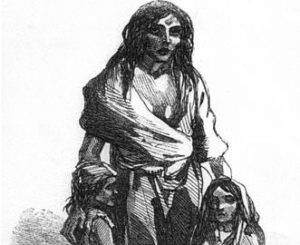


by Matt Farrell
Having lived most of my life in Edgeworthstown – the town that takes its name from the Edgeworth family – and having grown up in a home that nurtured a sense of community, it was inevitable that I should have an awareness of the Edgeworth family and even go on following in the Footsteps of Maria Edgeworth in England.

It all began with the arrival in our town of a Mrs. McElderry. She was the wife of the manager of Ulster Bank and she recognised the significance of the contribution that members of the Edgeworth family had made to society. Mrs. McElderry saw the possibilities of their legacy and took the opportunity to sympathetically exploit it for the benefit of the community. Thus, the establishment of the Edgeworth Society took place in 1969.
Edgeworthstown of the 1960’s and early 1970’s was not the ideal environment for the promotion of the legacy of an Anglo-Irish family who were seen as oppressors as opposed to white knights. However, despite these odds, and over 50 years on, the legacy still continues to be promoted, bringing pride to the local community.
Subsequently, my interest in them has taken me on a remarkable journey. My most recent journey was one of the most interesting and enjoyable, and I feel it is something I should share.
Back in the 1790’s, Richard Lovell Edgeworth and his family travelled extensively throughout England and the near continent, this being done when travel was a major undertaking. Yet, from their writings, it seemed to be second nature to them. For some time, I had been toying with the idea of following in their footsteps, but for some reason or another, I always found an excuse not to do so.
This all changed when I received a phone call from a long-time friend and acquaintance, Bernard Canavan. Bernard grew up a few doors down from me on Main Street, Edgeworthstown, and he was forced to emigrate to the UK at the age of 15. He carved out a remarkable life for himself and this included developing his natural talent for painting. Fortunately for myself and for Edgeworthstown, Bernard stayed in contact and over the years, has brought his wide range of experiences and knowledge to bear on our community and the Edgeworth Society.
Getting back to the call I received from Bernard…. It was the catalyst for a literary journey I undertook – following in the footsteps of Maria Edgeworth and her family in England. Throughout his life, Bernard had assembled an extensive library, mainly of Irish and Anglo-Irish interest. But feeling the onset of old age, he felt it was time to find a new home for his library – hence the call. Bernard had the library and we had the Maria Edgeworth Centre in Edgeworthstown. He saw our Centre as a suitable home for his collection and I saw it as a wonderful opportunity to acquire a fantastic literary collection that kept Bernard’s lifetime collection intact.
Getting the collection home to Edgeworthstown was the next challenge and this is where the journey began. Here was the moment when my dream of following in the footsteps of Maria Edgeworth in England and her remarkable family began to unfold.
Having committed to traveling to London to collect the books, I decided to turn my journey into a mini literary tour. It started with a friend, who gave me the loan of a van. Then went on to the more difficult task of convincing my 15-year-old grandson, Jamie, to join me on the journey.
Eventually, on Friday, the 1st July 2022, we headed off to Rosslare to catch the early Stena Line sailing to Fishguard. The sailing was pleasant and uneventful. We arrived in Fishguard before 11.00am from where we continued our journey to Bristol. Having read about the Edgeworth’s visits to Bristol and Clifton, I was looking forward to doing some exploring. This was when I realised that Bristol and Clifton are basically the one city!
Illness, mainly consumption, was a constant in the life of the Edgeworth family. As a result, Richard Lovell Edgeworth decided to take his third wife, Elizabeth, to Clifton in 1790. She was weakened by almost yearly pregnancies. Clifton and Bath, with their spas, were seen as places of healing. Maria was twenty-three at this time. Her father left her at home to look after her young siblings. Being delighted with Clifton, he requested Maria and the rest of the family to join them. Maria undertook the exhausting 33-hour journey to Holyhead and on to Clifton. A remarkable journey for a young woman to undertake!
Clifton was also the place where Dr. Beddoes, who married Maria’s sister, Anna, in 1792, carried out experiments with gases in his laboratory. Hoping the gases might provide cures for consumption – now known as Tuberculosis. Dr Beddoe’s apprentice was the young superstar of the period – Humphry Davy. His discovery of the anaesthetic effect of nitrous oxide in 1799, was a major contribution to surgery.

We made our way to 3 Rodney Place, Clifton – the home of Dr. Beddoes and his wife Ann. Undeniably, we were delighted to see a plaque on the wall commemorating Maria Edgeworth’s visit.
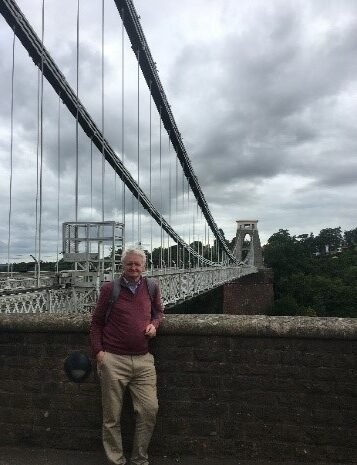
While in Clifton, we could not miss the opportunity to visit the famous Clifton Suspension Bridge. It crosses the spectacular Avon Gorge. The Gorge has its own microclimate and some rare species of plants, such as western spiked speedwell, Veronica spicata; dwarf sedge, Carex humilis and fingered sedge, Carex digitata, can be found growing in the gorge.
Maria Edgeworth lived here in Bristol for two years – from 1792 to 1793. Many of her stories in ‘The Parent’s Assistant’ and ‘Moral Tales’ are set in Bristol. The slave trade was closely associated with Bristol at the time. On one of Maria Edgeworth’s visits in England, she visited a slave ship and wrote of the appalling conditions on board. William Wilberforce was the leader of the movement to abolish slavery and was a friend of Maria’s and a visitor to Edgeworthstown.
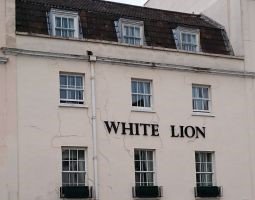
Our next stop was Bowood House. Bowood is currently owned by The Marquis and Marchioness of Lansdowne. Their predecessors were friends of the Edgeworth’s. Therefore, they visited Edgeworthstown on a number of occasions.
The house and gardens are a fine example of Georgian architecture. They are open to the public at certain times of the year. Obviously, it was a great experience to follow in the footsteps of Maria Edgeworth in England by visiting the estate. There is a wonderful library with a collection of over 5,000 books. It was mostly gathered by the 3 rd Marquess. He had a wide range of interests, covering literature, art, architecture, the sciences and travel. Here, the great Bowood House parties would meet after dinner to read, play chess, sing, talk about politics and other topics of the day and, perhaps, watch a scientific experiment performed by Dr. Priestley. Priestley is credited with the discovery of oxygen and subsequently the invention of carbonated water.
Maria Edgeworth and Thomas Moore were among the many visitors who enjoyed the generous and intellectually stimulating Lansdowne hospitality. Thomas Moore, (28 May 1779 – 25 February 1852) was an Irish writer, poet, and lyricist, celebrated for his ’Irish Melodies’ – a collection of folk songs. Their setting of English-language verse to old Irish tunes marked the transition in popular Irish culture from Irish to English. Politically, Moore was recognised in England as a press, or “squib”, writer for the aristocratic Whigs. In Ireland he was considered a Catholic patriot.
The following day, we headed into the beautiful city of Bath. It takes its name from the Roman Baths there and the city has been a well-being destination since Roman times.
Following our visit to the Roman Baths we headed to the Jane Austen Centre. The Jane Austen connection to Bath is well documented. We were introduced to the world of Jane Austen by guides in period costume and well versed in the life and times of Jane Austen.
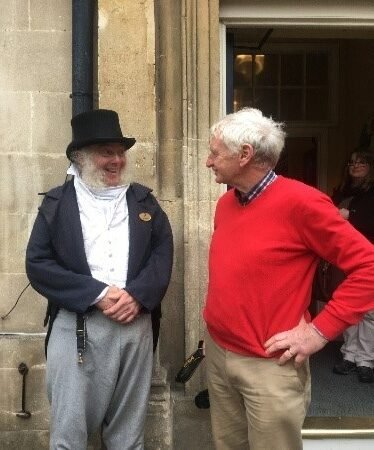
In her own lifetime, and for many years after her death, Jane Austen’s achievement as a novelist was entirely overshadowed by Maria Edgeworth. As late as 1870, in ’A Memoir of Jane Austen’, her nephew, James Edward Austen Leigh, wrote that if the Austen neighbours had known
“that we, in our secret thoughts, classed her with … Miss Edgeworth … they would have considered it an amusing instance of family conceit.”
It is interesting to find that, between the two writers themselves, there was, in the end, mutual respect and admiration. Furthermore, it is one of the ironies of literature that 150 years after the memoir, the reputations of the two writers has completely reversed. Now it is through Jane Austen that many readers come to rediscover the work of Maria Edgeworth, the author she admired so much. In a passage of Northanger Abbey, Austen writes:
“I have made up my mind to like no novels really, but Miss Edgeworth’s, yours and mine.”
From here, we took the tourist bus which gave us a quick snapshot of the impressive buildings, including the famous Royal Crescent. Lastly, we could not leave Bath without visiting another Edgeworth connection. It was the home of William Herschel, who Maria Edgeworth greatly admired. Maria visited the Herschel’s in Bath and we know that William and his son, John, visited Edgeworthstown. William Herschel was German born and moved to England at the age of 19. He became the Royal Astronomer and is credited with discovering the planet Uranus. Additionally, he worked closely with his sister Caroline, who was the first female pioneer in the world of science and astronomy. Caroline is credited with discovering a number of comets. Like Maria, she was made an associate member of the Royal Irish Academy.
Our journey continued on to London to meet up with Bernard Canavan. As mentioned, Bernard kindly gifted the Maria Edgeworth Centre a large section of his extensive library. Whilst in London, we again took the tourist bus around the city.
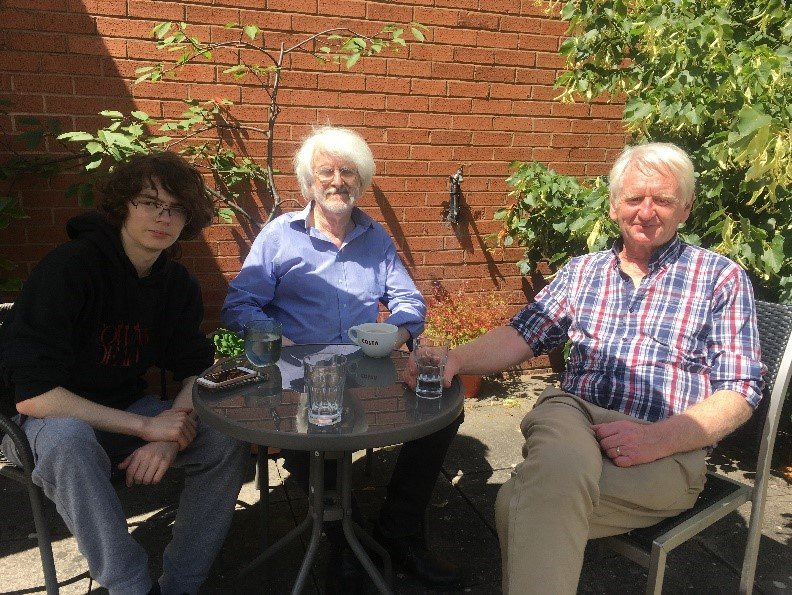
Furthermore, we visited Apsley House, located beside Marble Arch. This was the home of Kitty Pakenham, Duchess of Wellington. Kitty was married to the Duke of Wellington, and was a great friend of Maria and the Edgeworth family. In February of 1831, Maria wrote a moving account of her visit to the Duchess who she described as being a tiny, pale, shrunken figure in the splendid drawing room of Apsley House. On a return visit on the 9th of April, Maria was to learn of Kitty’s death the previous day, with the Duke by her side. Maria was given a lock of her hair and quietly departed. The Duke of Wellington, (Arthur Wellesley) was born in Dublin, and became celebrated in England as a military and political figure, twice serving as Britain’s Prime Minister.

Further, she remarks in her letter, the Edgeworths were incredibly ‘fortunate […[ to come to the Carrs‘ just at the moment we did’. Shortly after their arrival in Hampstead, Fanny fell ill with a violent cold as the result of a draughty visit to the theatre. However, Maria firmly believed that Fanny’s feverish state had been brought on because she had been ‘too much harassed’ by ‘the struggle of her mind & the pain’ of deciding to reject Lestock Wilson’s proposal of marriage. The Edgeworth family was opposed to the marriage. Nevertheless, Fanny later married Lestock in 1829. Maria was full of anxiety as she struggled to decide whether to call a doctor or return to London as planned and risk Fanny’s further exposure to Lestock Wilson’s pursuit.
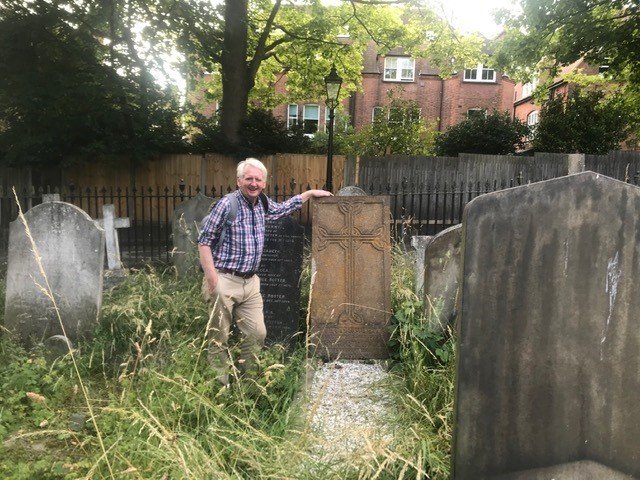
During our visit, Bernard was kind enough to take us to another location associated with Maria Edgeworth in England – 8 Church Row, Hampstead Heath. This was the home of family friends, the Carrs. John Carr was Solicitor to the Treasury, and he and his family visited Edgeworthstown on many occasions. Maria, Fanny and Honora were in London and decided to visit Hampstead. Maria described in a letter, ‘at last we could enjoy a delicious day in the mists of spring delights’.
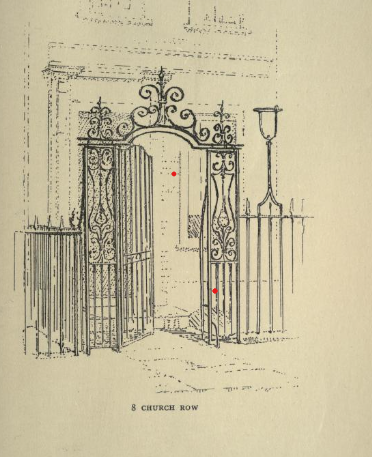
Afterwards, Bernard was anxious to show me some interesting graves. At the end of Church Row was a quaint church and adjoining graveyard. First was the grave of the great English landscape painter, John Constable, and not far from his grave, was the grave of Eva Gore-Booth. She is interred with her life-long partner Esther Roper. Evidently, Eva Gore-Booth’s sexuality has been a topic for debate among academics for years, some of whom argue that she and Esther Roper were in a same sex relationship, others arguing that the two women merely cohabited.
Having spent the night in ‘The Crown’ in Cricklewood, now a Clayton Hotel, we headed for Oxford. In Oxford, we were welcomed to Mansfield College by our friend, Professor Ros Ballaster. After settling into our accommodation in the college, we set about exploring Oxford with its splendid buildings and magnificent spires.
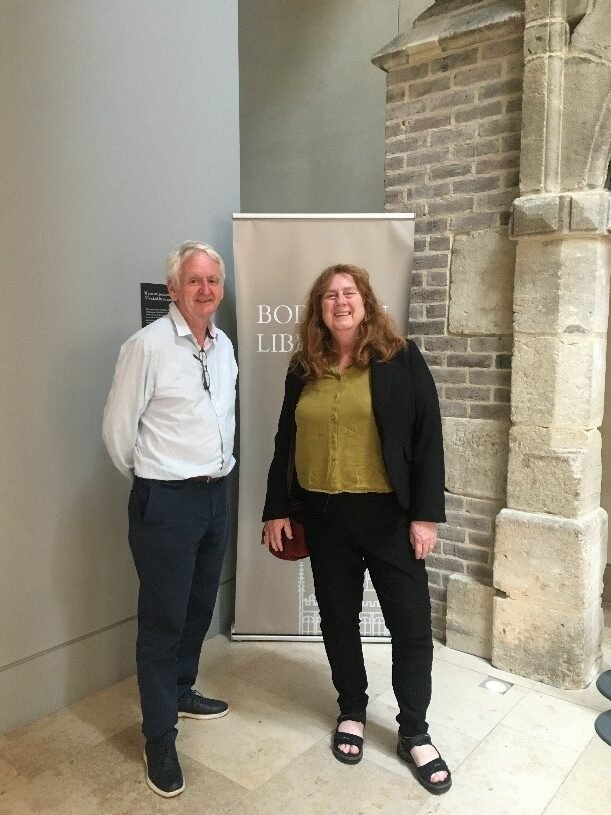
In the afternoon, we were welcomed to the wonderful setting of the Bodleian Library. The Bodleian has played a major role in preserving and cataloguing the vast collection of Edgeworth letters and manuscripts. It was an enjoyable experience to search through these amazing papers that were laid out for us in the reading room by the dedicated staff of the Bodleian. We also had the opportunity to view the Edgeworth-Holland papers, a recently acquired collection by the library.
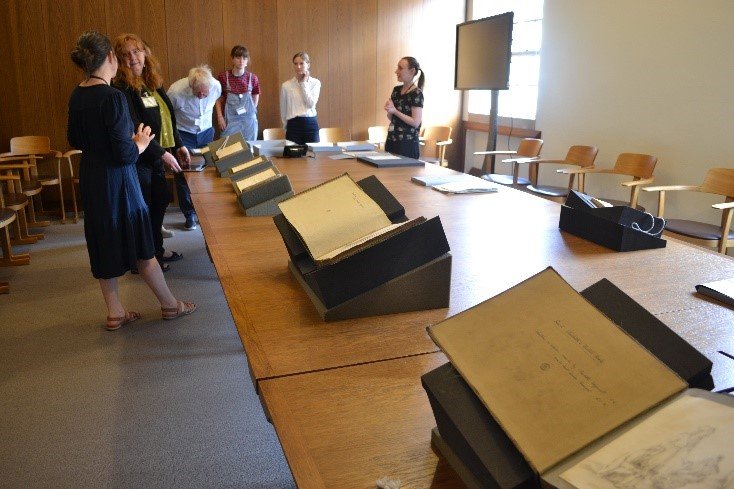

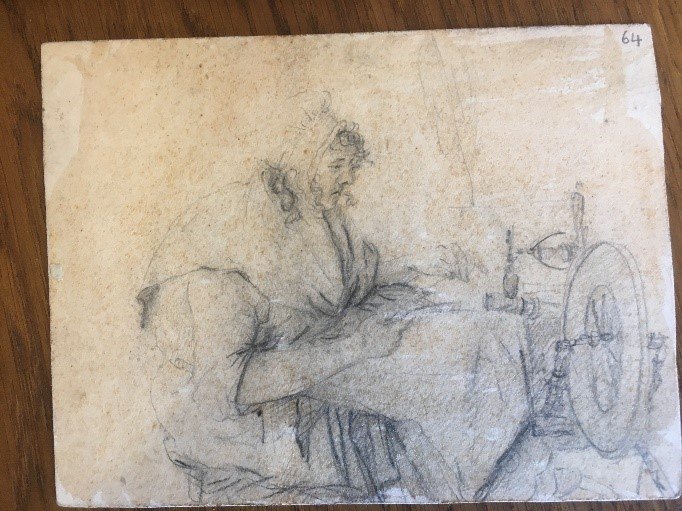
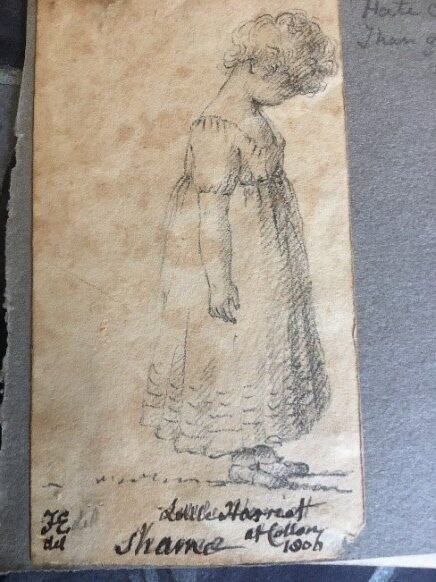
We spent the evening in the splendid setting of Mansfield College. Rising early, we enjoyed breakfast in the beautiful dining room. After a boat trip down the Thames, with its university boathouses and ancient locks, we headed off for Lichfield.
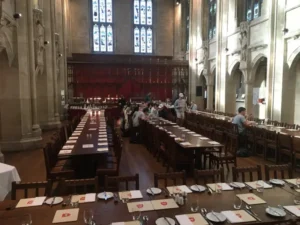
Our reason for visiting Lichfield was because it was the home of Richard Lovell Edgeworth’s dear friend, Erasmus Darwin. He lived in the splendid Lichfield House, located beside the wonderful Lichfield Cathedral.
It was in Lichfield House that Richard Lovell Edgeworth met the love of his life, Honora Sneyd. She was a writer and poet, a friend of Anna Seward and members of the Lunar Society of Birmingham. It was lovely to see the Edgeworths’ remembered here in Lichfield.
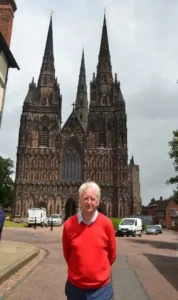
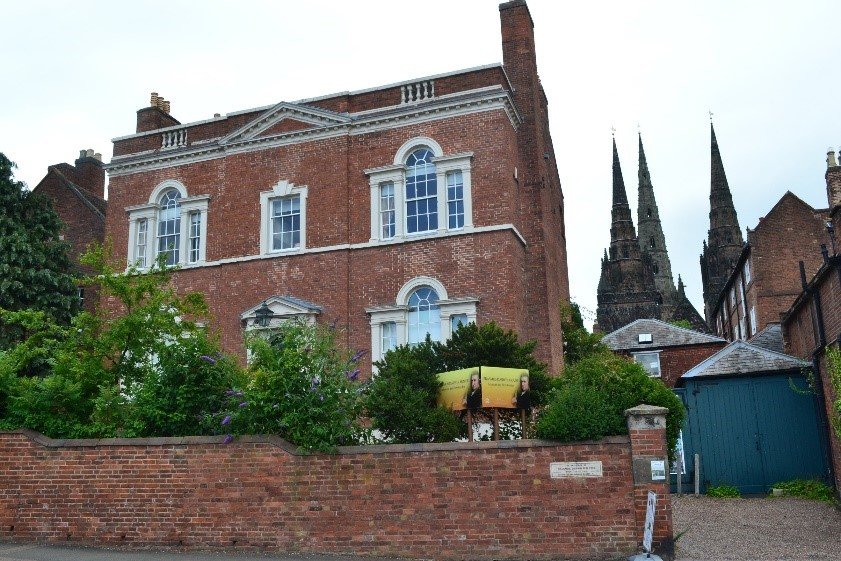
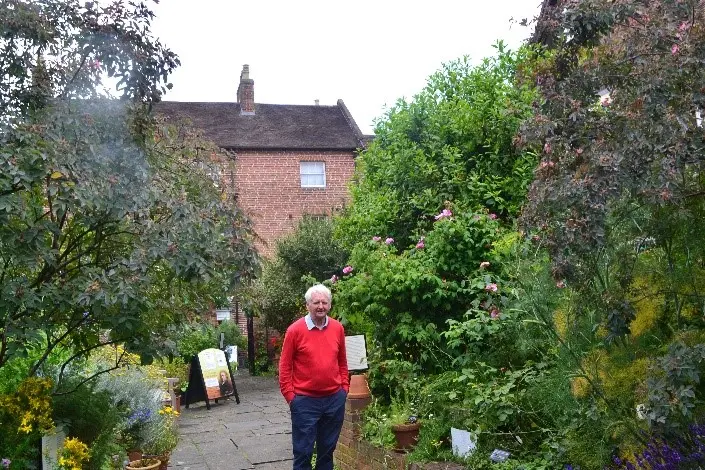
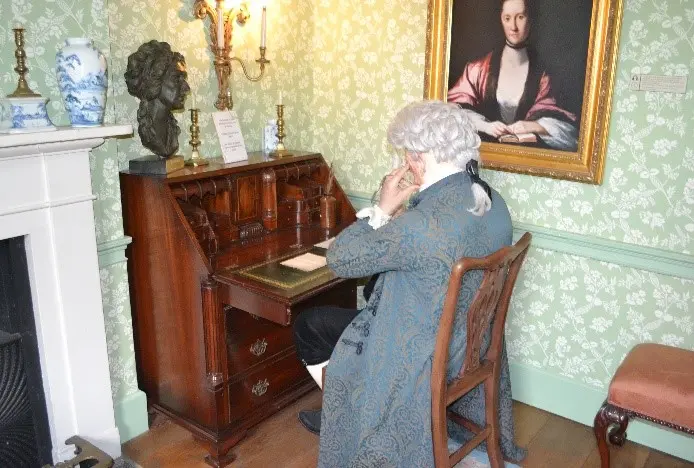
Before leaving Lichfield, we paid a visit to another house with Edgeworthstown connections. Lichfield is the birthplace of Samuel Johnson who was a great friend of Oliver Goldsmith. It must be remembered that Goldsmith received his classical education in Edgeworthstown and resided at St John’s Rectory there.
Exhausted but exhilarated by all the cultural connections, we headed off for Hollyhead and the trip back to Edgeworthstown. Bernard had anxieties about getting the books through customs. But these were allayed when the friendly female customs officer, following a quick inspection, waved us through and wished us well with our reading!
The consignment of books from London were safely stored in the library in Edgeworthstown. Here they are currently being catalogued before being moved to the Maria Edgeworth Centre.
All in all, I was delighted that I undertook the journey to follow in the footsteps of Maria Edgeworth in England, and to see some of the places I had envisaged from my reading. Lastly, I must also say, that this journey did not cover all the places visited by Maria and there is a lot more to discover. Therefore, I look forward to repeating the trip – maybe with some Edgeworth enthusiasts from Edgeworthstown to unearth more of Maria’s footsteps.
The best way to keep in touch and to be aware of our events
Don’t forget to confirm your subscription in the Email we just sent you!

Please pre-book your visit over Christmas at least 24h in advance via Email or Online booking.
MondayClosed
Tuesday10:00 AM - 5:00 PM
Wednesday10:00 AM - 5:00 PM
Thursday10:00 AM - 5:00 PM
Friday10:00 AM - 5:00 PM
Saturday11:00 AM - 5:00 PM
Sunday11:00 AM - 5:00 PM
Adult €7.50
Children 10 to 16 €3
2 Adults & 2 Children €15
Adult is 16 years+
Family Ticket is 4 family members together
Children under ten are free but must be accompanied by an Adult

The Maria Edgeworth Centre is operated under the direction of the Edgeworthstown District Development Association (EDDA) – a Not for Profit Voluntary Community based registered charity Reg:223373. Registered Charity Number 20101916
© 2023 Maria Edgeworth Centre – All Rights Reserved
On the 17th of August 2024 as part of Heritage Week, with support from the County Heritage Officers, the Heritage Council, Longford County Council Libraries, Archives, Arts and Heritage,
IMMA, OPW and the Computer and Communications Museum Ireland on the NUIG Campus,
Ray Jordan and volunteers from the Maria Edgeworth Centre aim to simulate Edgeworth’s 1803 transmission by telegraph.
Click the link below to learn more or to register to attend either in person or via Zoom.
Join us for this recreation of a key moment in the history of communications